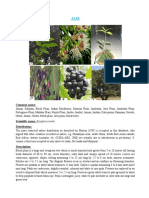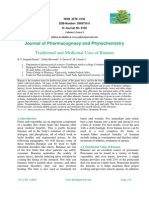Bitter Gourd
Bitter Gourd
Uploaded by
marianaivanovaprofCopyright:
Available Formats
Bitter Gourd
Bitter Gourd
Uploaded by
marianaivanovaprofOriginal Description:
Copyright
Available Formats
Share this document
Did you find this document useful?
Is this content inappropriate?
Copyright:
Available Formats
Bitter Gourd
Bitter Gourd
Uploaded by
marianaivanovaprofCopyright:
Available Formats
Momordica charantia
Health Benefits of Bitter Gourd
Bitter gourd/melon is one of the best plant foods
that helps improve diabetic and toxemia conditions.
Description
The bitter melon (also known as bitter gourd) looks like a
cucumber but with ugly gourd-like bumps all over it.
As the name implies, this vegetable is a melon that is
bitter. There are two varieties of this vegetable: One grows
to about 20 cm long, is oblong and pale green in color. The
other is the smaller variety, less than 10 cm long, oval and
has a darker green color.
Both varieties have seeds that are white when unripe and
that turn red when they are ripe. The vegetable-fruit turn
reddish-orange when ripe and becomes even more bitter.
Bitter gourd thrives in hot and humid climates, so are
commonly found in Asian countries and South America.
Westerners may not be so used to bitter melons, so may
find them more difficult to consume. But if you can generally take bitter taste, you
may be able to take this too. Try it, at least for all its healthful virtues!
Nutritional Benefits
Bitter gourds are very low in calories but dense with precious nutrients. It is an
excellent source of vitamins B1, B2, and B3, C, magnesium, folate, zinc, phosphorus,
manganese, and has high dietary fiber. It is rich in iron, contains twice the beta-
carotene of broccoli, twice the calcium of spinach, and twice the potassium of a
banana.
Bitter melon contains a unique phyto-constituent that has been confirmed to have
a hypoglycemic effect called charantin. There is also another insulin-like
compound known as polypeptide P which have been suggested as insulin
replacement in some diabetic patients.
Health Benefits
Few other fruits/vegetables offer medicinal properties for these ailments like
bitter melon does.
Blood disorders: Bitter gourd juice is highly beneficial for treating blood
disorders like blood boils and itching due to toxemia. Mix 2 ounces of fresh bitter
gourd juice with some lime juice. Sip it slowly on an empty stomach daily for
between four and six months and see improvement in your condition.
Cholera: In early stages of cholera, take two teaspoonfuls juice of bitter gourd
leaves, mix with two teaspoonfuls white onion juice and one teaspoonful lime juice.
Sip this concoction daily till you get well.
Diabetes mellitus: Bitter melon contains a hypoglycemic compound
(a plant insulin) that is highly beneficial in lowering sugar levels in blood and
urine. Bitter melon juice has been shown to significantly improve glucose tolerance
without increasing blood insulin levels.
Energy: Regular consumption of bitter gourd juice has been proven to improve
energy and stamina level. Even sleeping patterns have been shown to be
improved/stabilized.
Eye problems: The high beta-carotene and other properties in bitter gourd makes
it one of the finest vegetable-fruit that help alleviate eye problems and improving
eyesight.
Gout: Bitter gourd juice is liver cleansing. It helps clean up a toxic blood, improves
blood circulation and relieves gout pain.
Hangover: Bitter melon juice may be beneficial in the treatment of a hangover for
its alcohol intoxication properties. It also help cleanse and repair and nourish liver
problems due to alcohol consumption.
Immune booster: This bitter juice can also help to build your immune system and
increase your bodys resistance against infection.
Piles: Mix three teaspoonfuls of juice from bitter melon leaves with a glassful of
buttermilk. Take this every morning on empty stomach for about a month and see
an improvement to your condition. To hasten the healing, use the paste of the roots
of bitter melon plant and apply over the piles.
Psoriasis: Regular consumption of this bitter juice has also been known to
improve psoriasis condition and other fungal infections like ring-worm and
athletes feet.
Respiratory disorders: Take two ounces of fresh bitter melon juice and mix with
a cup of honey diluted in water. Drink daily to improve asthma, bronchitis and
pharyngitis.
Toxemia: Bitter gourd contains beneficial properties that cleanse the blood from
toxins. Sip two teaspoonfuls of the juice daily to help cleanse the liver. Also helpful
in ridding jaundice for the same reasons.
Consumption Tips
Choose unripe bitter melons that are firm, like how you would a cucumber. Avoid
those that have turned orange or have soft spots. Ripe bitter melons can be
excessively bitter.
Store bitter melons in the vegetable bin in the refrigerator which has the right
temperature. It should keep for three to four days.
Keeping bitter melons at room temperature or with other fruits and vegetables will
hasten the melon to ripen and become more bitter, due to the emission of ethylene
gas.
Clean your bitter melon under cold running water and brush with a soft vegetable
brush. To prepare, slice the melon length-wise and scoop out the seeds. To lessen
the bitter flavor, soak it in salt water for about half an hour before juicing/cooking.
The smaller variety is more bitter than the bigger one. To help make bitter gourd
juice more palatable, take it with honey, or add carrot or apple juice. For diabetics,
drink the juice with green apple juice.
Caution
Do not consume more than two ounces of bitter melon, or more than two melons a
day. Excessive consumption may cause mild abdominal pain or diarrhea. Diabetics
taking hypoglycemic drugs will need to alter the dosage of their drugs if they
consume bitter melon on a regular basis. Please consult your doctor.
Pregnant women should avoid taking too much bitter gourd or its juice as it may
stimulate the uterus that may lead to preterm labor.
Bitter Melon and Diabetes
Bitter melon can reduce blood glucose levels but more research is required
Bitter melon, also known as bitter gourd or karela (in India), is a unique vegetable-
fruit that can be used as food or medicine. It is the edible part of the plant
Momordica Charantia, which is a vine of the Cucurbitaceae family and is
considered the most bitter among all fruits and vegetables.
The plant thrives in tropical and subtropical regions, including:
South America
Asia
parts of Africa
the Caribbean
The bitter melon itself grows off the vine as a green, oblong-shaped fruit with a
distinct warty exterior - though its size, texture and bitterness vary between the
different regions in which it grows - and is rich in vital vitamins and minerals.
How does it affect diabetes?
In addition to being a food ingredient, bitter melon has also long been used as a
herbal remedy for a range of ailments, including type 2 diabetes.
The fruit contains at least three active substances with anti-diabetic properties,
including charantin, which has been confirmed to have a blood glucose-lowering
effect, vicine and an insulin-like compound known as polypeptide-p.
These substances either work individually or together to help reduce blood sugar
levels.
It is also known that bitter melon contains a lectin that reduces blood glucose
concentrations by acting on peripheral tissues and suppressing appetite - similar
to the effects of insulin in the brain.
This lectin is thought to be a major factor behind the hypoglycemic effect that
develops after eating bitter melon.
Scientific evidence
A number of clinical studies have been conducted to evaluate the efficacy of bitter
melon in the treatment of diabetes.
Bitter Melon on the Diabetes Forum
Karela bitter melon tablets
Bitter Melon/Kerala Fruit
Cinnamon and Bitter Melon for reducing fasting levels
Bitter melon
Bitter melon extract
In January 2011, the results of a four-week clinical trial were published in the
Journal of Ethnopharmacology, which showed that a 2,000 mg daily dose of bitter
melon significantly reduced blood glucose levels among patients with type 2
diabetes, although the hypoglycemic effect was less than a 1,000 mg/day dose of
metformin. [68]
Other older studies have also suggested an association between bitter melon
intake and improved glycemic control, while a report published in the March 2008
issue of Chemistry and Biology found that bitter melon increased cellular uptake of
glucose and improved glucose tolerance. [69]
However, research published in the Journal of Clinical Epidemiology in 2007 failed
to show any benefits of bitter melon for poorly controlled type 2 diabetes, while
another clinical review published two years later in the British Journal of Nutrition
stated that more, better-designed and clinical trials are required to confirm the
fruits role in diabetes treatment.
What other health benefits does it have?
Bitter melon is used in traditional medicine for:
Colic
Fever
Burns
Chronic cough
Painful menstruation
Skin conditions
It is also used to heal wounds, assist childbirth and, in parts of Africa and Asia,
prevent or treat malaria and viral diseases such as measles and chicken pox.
In addition, researchers from Saint Louis University in the US say they have shown
that an extract from bitter melon can kill breast cancer cells and prevent them
from growing and spreading.
cacana 1. n. f. planta, Momordica balsamina, usada
para a alimentao e para fins medicinais, sobretudo
em infuso; 1. O dicionrio Porto Editora regista o
moambicanismo, definindo cacana como planta
trepadeira cujas folhas e frutos so comestveis.
Segundo este dicionrio, a palavra cacana vem do
ronga nkakana. No Brasil, a planta designada
como balsamina de purga.
Bitter Gourd
Scientific Name : Momordica Charantia
L.
Family : Cucurbitacea
Colour : Light Green
Common names : Bitter gourd, Bitter
melon, Bitter cucumber, Karela (Hindi),
Balsam pear, Balsam apple
Best Season : Throughout the year
Nutritional Value : 44 kcal, 5.6 g
protein, 290 mg calcium, 5 mg iron, 5.1
mg vitamin A, 170 mg vitamin C per
100 g serving.
RECIPES
Bitter gourd is a fast growing warm seasonal climbing annual, native to South Asia.
Considered one of the most nutritious gourds, the plant has medicinal properties. A
compound known as 'charantin' present in the bitter gourd is used in the treatment of
diabetes to lower blood sugar levels. The plant also has a rich amount of Vitamin A,
vitamin C, iron, phosphorus and carbohydrates. There are several varieties available,
having fruits 3-4 inches to even 12inches in length.
This vine has a slender hairy stem with numerous branches and dense foliage. The plant
grows up to 6 feet tall and develops small, yellow flowers both male and female, on the
same plant. The fruits are green usually oblong, has an irregular surface with warts and
8-10 vertical ridges. When ripe, the fruits turn yellowish orange in colour.
Propagation and Planting :
Mainly a warm season plant, bitter gourd thrives in hot and humid climates. Propagation
is through direct seeding and transplanting. The best medium for the seeds is a fertile,
well drained soil with a pH ranging from 5.5 to 6.7, enriched with organic matter, such
as compost or dried manure. But it will tolerate any soil that provide a good drainage
system. The soil must be prepared well by adding organic matter before planting.
Two or three seeds can be sown together in a pit 1/2 inch deep. Water lightly. For better
results soak the seeds in water 24 hours before sowing. The seeds will germinate in 2-3
days. The germinated seeds can be replanted on raised beds 18-20 inches apart.
Transplants should be done in such a way as to avoid disturbance to the root system. As
the plants grow, place poles 2m.high and give wire or twine supports in rows across the
poles.
Regular watering with plenty of water is essential for its growth. Flowers will start
appearing in 5-6 weeks and fruition will occur between two to four months. Mature
fruits are ready to be picked within3 months from planting and they will be light green
and juicy with white flesh but bitter. Pick the fruits every 2-3 days when they are still at
the tender stage. Regular picking is important as fruits will become more bitter as they
mature and it can also hamper the growth of new fruits.
Leave some fruits to reach full maturity if they have to be reserved for subsequent
crops. When fully mature, the fruits will break open on its own and release brown or
white seeds which can be collected.
Problems and Care :
Vines should be pruned at the tips when female flowers start developing to encourage
branching and fast bearing. Regular fertilizing is essential for its growth. Water
immediately after applying fertilizers.
Bitter gourd is susceptible to many diseases and insect pests. It is susceptible to
watermelon mosaic virus, other cucurbit viruses and powdery mildew, which can be
controlled by sulfur dust. Rust disease is controlled by spraying foliage with
oxycarboxin. The fruits are subject to attack by various fruit flies and fruit rots. Pests
attack on fruits can be prevented by wrapping fruits with newspapers, when they are
about a few centimetres long.
You might also like
- Healthy Smoothies Weight LossDocument13 pagesHealthy Smoothies Weight LossTiffany Brown91% (11)
- HBA1C Report - 25 Jan 23Document2 pagesHBA1C Report - 25 Jan 23Paranjoy DasNo ratings yet
- Gastitis Foods To EatDocument12 pagesGastitis Foods To EatanitagugnaniNo ratings yet
- C1 Kurs-Und Ubungsbuch LosungenDocument35 pagesC1 Kurs-Und Ubungsbuch LosungenmarianaivanovaprofNo ratings yet
- 2018 Medtronic Diabetes Investor BriefingDocument29 pages2018 Medtronic Diabetes Investor BriefingmedtechyNo ratings yet
- Joslin Diabetes Center and Joslin Clinic Guideline For Detection and Management of Diabetes in PregnancyDocument10 pagesJoslin Diabetes Center and Joslin Clinic Guideline For Detection and Management of Diabetes in Pregnancyyulia fatma nstNo ratings yet
- Devitt AA Et Al. J Diabetes Res Clin Metab. 2012 1 20Document9 pagesDevitt AA Et Al. J Diabetes Res Clin Metab. 2012 1 20Teresa100% (1)
- RTD NovoMix 2017Document56 pagesRTD NovoMix 2017bayu permasuthaNo ratings yet
- Bitter GourdDocument5 pagesBitter GourdChristian Nimako-BoatengNo ratings yet
- Benefits of Fruit and Vegetables For HealthDocument45 pagesBenefits of Fruit and Vegetables For HealthKafid BramNo ratings yet
- AmpalayaDocument4 pagesAmpalayaTomas Madayag IIINo ratings yet
- Surprising Benefits of Bitter Melon For DiabetesDocument41 pagesSurprising Benefits of Bitter Melon For DiabetesnajihahNo ratings yet
- Herbal Remedies: A Study On Natural Anti Diabetic /anti Cholesterolemic Foods Illustrating Mechanism of ActionDocument14 pagesHerbal Remedies: A Study On Natural Anti Diabetic /anti Cholesterolemic Foods Illustrating Mechanism of ActionPrathibha GunasekarNo ratings yet
- AMPALAYADocument7 pagesAMPALAYAMyzhel InumerableNo ratings yet
- Am Pa Lay ADocument13 pagesAm Pa Lay ADestinedforgreatnessNo ratings yet
- Makalah Bahasa InggrisDocument10 pagesMakalah Bahasa InggrisSilmiAiraNo ratings yet
- Bitter Gourd (Momordica Charantia) As Fresh LumpiaDocument19 pagesBitter Gourd (Momordica Charantia) As Fresh LumpiaDIANNA ROSE CORTEZNo ratings yet
- Banaba Herbal Tea Is Also Used For Sustained WeightDocument5 pagesBanaba Herbal Tea Is Also Used For Sustained WeightAveriAlonzoNo ratings yet
- Bitter Leaf - A Wonder VegetableDocument6 pagesBitter Leaf - A Wonder VegetableGoodnessNo ratings yet
- Herbal Medicines Approved by Department of Health DohDocument5 pagesHerbal Medicines Approved by Department of Health DohDenise Danielle TorresNo ratings yet
- Tateishi's Cancer Healing FormulaDocument8 pagesTateishi's Cancer Healing FormulaSyafiq Abdullah100% (1)
- Herbs That Lower Blood Sugar: Click Here To Email This ArticleDocument5 pagesHerbs That Lower Blood Sugar: Click Here To Email This ArticleEdy Tagz TaguiamNo ratings yet
- Diabetes and Natural RemediesDocument4 pagesDiabetes and Natural RemediesMaja MudriNo ratings yet
- CancerDocument1 pageCanceresivaks2000No ratings yet
- Products Anti Diabetes For Type 1 and Type 2 Diabetes Natto Roots Momordica Balsamina Caju Bark Artemisia Afra TinctureDocument5 pagesProducts Anti Diabetes For Type 1 and Type 2 Diabetes Natto Roots Momordica Balsamina Caju Bark Artemisia Afra TinctureNile Valley MedicineNo ratings yet
- HahayysDocument30 pagesHahayys2BGrp3Plaza, Anna MaeNo ratings yet
- Balsam Apple: A Tool For Diabetes, Cancer, and Skin Conditions Against DeteriorationDocument4 pagesBalsam Apple: A Tool For Diabetes, Cancer, and Skin Conditions Against DeteriorationFrancois Cyrus EsletaNo ratings yet
- Guyabano TeaDocument9 pagesGuyabano TeaNadia PetrolaNo ratings yet
- Pharmacognosy Anti-DiabeticDocument4 pagesPharmacognosy Anti-DiabeticMelavNo ratings yet
- Alternative Health & Herbs Remedies 425 Jackson SE, Albany, OR 97321 1-541-791-8400Document159 pagesAlternative Health & Herbs Remedies 425 Jackson SE, Albany, OR 97321 1-541-791-8400Marvin T Verna100% (3)
- How To Make Papaya Leaf Juice?Document12 pagesHow To Make Papaya Leaf Juice?Sana MobinNo ratings yet
- Common Name:: Syzygium CuminiDocument4 pagesCommon Name:: Syzygium CuminiJahanara AkterNo ratings yet
- Scope and Limitations of The StudyDocument7 pagesScope and Limitations of The StudyNica Nebreja25% (4)
- Dr Barbara Cure for Gout: The Concise Guide on How to Treat and Reverse Gout with the Help of Barbara O’Neill Herbs and Herbal MedicineFrom EverandDr Barbara Cure for Gout: The Concise Guide on How to Treat and Reverse Gout with the Help of Barbara O’Neill Herbs and Herbal MedicineNo ratings yet
- All Natural Wellness Drinks: Teas, Smoothies, Broths, and Soups. Anti-Cancer, Anti-Aging, Anti-Inflammatory, Anti-Viral, Anti-Diabetic and Anti-Oxidant Drinks: Essential Spices and Herbs, #5From EverandAll Natural Wellness Drinks: Teas, Smoothies, Broths, and Soups. Anti-Cancer, Anti-Aging, Anti-Inflammatory, Anti-Viral, Anti-Diabetic and Anti-Oxidant Drinks: Essential Spices and Herbs, #5Rating: 5 out of 5 stars5/5 (1)
- Bitter but BetterDocument2 pagesBitter but Bettere.pusta.554148No ratings yet
- 17 Best Benefits of Guava LeavesDocument34 pages17 Best Benefits of Guava LeavesRonel DayoNo ratings yet
- 20 Home Remedies For Diabetes Type 2Document5 pages20 Home Remedies For Diabetes Type 2leonard1971No ratings yet
- Organic PomegranateDocument2 pagesOrganic PomegranateHaider ShahNo ratings yet
- Review of Related Literature and Studies: The Bitterness Is Proportionate To Its PotencyDocument6 pagesReview of Related Literature and Studies: The Bitterness Is Proportionate To Its PotencyRoby IbeNo ratings yet
- Neem LeafDocument8 pagesNeem LeafRamonaNo ratings yet
- Top 10 Super Healing FoodsDocument26 pagesTop 10 Super Healing FoodsMichael Vítek100% (1)
- Ginger: SensitivityDocument6 pagesGinger: SensitivityMaría AriasNo ratings yet
- Why You Need To Eat That Fruit: A Compendium of Fruits and their Health BenefitsFrom EverandWhy You Need To Eat That Fruit: A Compendium of Fruits and their Health BenefitsNo ratings yet
- Super Foods That Reverse Diabetes NaturallyDocument9 pagesSuper Foods That Reverse Diabetes NaturallyAshishNo ratings yet
- Pumpkin Nutrition FactsDocument196 pagesPumpkin Nutrition FactsPriya Bisht100% (1)
- Banana PDFDocument13 pagesBanana PDFRetno Sumara50% (2)
- Ampalaya FaqDocument9 pagesAmpalaya Faqjaja59No ratings yet
- "Natural Healing With Herbs For A Healthier You": DandelionDocument5 pages"Natural Healing With Herbs For A Healthier You": Dandelionak09100% (1)
- Garlic: Blood Pressure Lowering HerbsDocument4 pagesGarlic: Blood Pressure Lowering HerbsEdwin Delos Reyes AbuNo ratings yet
- Cancer Treatment With Soursop LeafDocument4 pagesCancer Treatment With Soursop LeafSueEverethNo ratings yet
- Food For Your Eyes - Juicing, Smoothie & Green Drink Recipes For EyesightDocument5 pagesFood For Your Eyes - Juicing, Smoothie & Green Drink Recipes For EyesightdreamerNo ratings yet
- New Moringa TeaDocument6 pagesNew Moringa TeaAhmed MirzaNo ratings yet
- A Research Review of Bitter MelonDocument4 pagesA Research Review of Bitter Melonstevenheise100% (2)
- The Diabetic NutriBullet Recipe Guide: 100+NutriBullet Diabetes Blasting Ultra Low Carb Delicious and Health Optimizing Nutritious Juice and Smoothie RecipesFrom EverandThe Diabetic NutriBullet Recipe Guide: 100+NutriBullet Diabetes Blasting Ultra Low Carb Delicious and Health Optimizing Nutritious Juice and Smoothie RecipesNo ratings yet
- Is Your Food What: ? ColorDocument8 pagesIs Your Food What: ? ColorEyog VictoriaNo ratings yet
- Group 6 ResearchDocument4 pagesGroup 6 ResearchRhea MandatoNo ratings yet
- AmpalayaDocument4 pagesAmpalayaAnthony CorporalNo ratings yet
- 20 Herbal MedicineDocument8 pages20 Herbal MedicineJhuneMarie Bucad100% (1)
- Detox DietDocument4 pagesDetox Dietsingh.reefsNo ratings yet
- Diet Treatment For Gastritis-Tratament GastritaDocument17 pagesDiet Treatment For Gastritis-Tratament Gastritaioana1103No ratings yet
- Get a Boost with Green Smoothie Recipes: 40+ Recipes to Trigger Weight Loss and Improve HealthFrom EverandGet a Boost with Green Smoothie Recipes: 40+ Recipes to Trigger Weight Loss and Improve HealthNo ratings yet
- Smoothies and Juicing Recipes PDFDocument11 pagesSmoothies and Juicing Recipes PDFAbisaiNo ratings yet
- ProdguidebeetrootDocument16 pagesProdguidebeetrootmarianaivanovaprofNo ratings yet
- NutritionManuals References FinalDocument19 pagesNutritionManuals References FinalmarianaivanovaprofNo ratings yet
- Beets: Agriculture and Natural ResourcesDocument3 pagesBeets: Agriculture and Natural ResourcesmarianaivanovaprofNo ratings yet
- APA2013 Book of AbstractsDocument210 pagesAPA2013 Book of Abstractsmarianaivanovaprof100% (1)
- Farm Field Day EvaluationDocument1 pageFarm Field Day EvaluationmarianaivanovaprofNo ratings yet
- I'm Good at ReadingDocument11 pagesI'm Good at ReadingmarianaivanovaprofNo ratings yet
- Sem in Is Tomato Disease GuideDocument81 pagesSem in Is Tomato Disease GuidemarianaivanovaprofNo ratings yet
- Plant Sample For Plant AnalysisDocument6 pagesPlant Sample For Plant Analysismarianaivanovaprof100% (1)
- Booklet Yellow and Orange FoodreportDocument65 pagesBooklet Yellow and Orange FoodreportmarianaivanovaprofNo ratings yet
- Edible Veg OilsDocument12 pagesEdible Veg OilsmarianaivanovaprofNo ratings yet
- ASEAN Manual of Food AnalysisDocument196 pagesASEAN Manual of Food Analysisaria1354100% (2)
- Beet & Beetroot: Detroit Dark RedDocument77 pagesBeet & Beetroot: Detroit Dark RedmarianaivanovaprofNo ratings yet
- REVIEW JURNAL DM Kelompok 4Document68 pagesREVIEW JURNAL DM Kelompok 4Ratu AnandaNo ratings yet
- Health Education Project 1Document20 pagesHealth Education Project 1api-509048557No ratings yet
- 239.mudassar DIABETES, PMDC 3811 PAID, Bushra 4011 Not PaidDocument8 pages239.mudassar DIABETES, PMDC 3811 PAID, Bushra 4011 Not PaidraychandwpNo ratings yet
- Dipeptidyl Peptidase IV (DPP IV) : A Novel Emerging Target For The Treatment of Type 2 DiabetesDocument8 pagesDipeptidyl Peptidase IV (DPP IV) : A Novel Emerging Target For The Treatment of Type 2 DiabetesGREESTYNo ratings yet
- Relationship Between Glycated Haemoglobin and Lipid Profile in Diabetic Patients in Port Harcourt J Rivers StateDocument8 pagesRelationship Between Glycated Haemoglobin and Lipid Profile in Diabetic Patients in Port Harcourt J Rivers Stateijmb333No ratings yet
- Diabetic Foot - Case PresentationDocument54 pagesDiabetic Foot - Case PresentationMarlon Abad88% (8)
- Jadwal JDM FinalDocument16 pagesJadwal JDM Finaltersi astariNo ratings yet
- Exenatide Response in An Adolescent's Morbid Obesity: Pharmacology & Pharmacy, 2014, 5, 419-424Document6 pagesExenatide Response in An Adolescent's Morbid Obesity: Pharmacology & Pharmacy, 2014, 5, 419-424CamiNo ratings yet
- JOralResRev10296-5161171 142011 PDFDocument5 pagesJOralResRev10296-5161171 142011 PDFIbrahim AliNo ratings yet
- Pathophysiology of DiabetesDocument88 pagesPathophysiology of DiabetesCahya SetiyaNo ratings yet
- Family Nursing Care PlanDocument5 pagesFamily Nursing Care PlanMarlchiel Nathan ArregladoNo ratings yet
- Medical Surgical Nursing More QuestionsDocument8 pagesMedical Surgical Nursing More QuestionslaniNo ratings yet
- Magie Maureen Chapter 4Document31 pagesMagie Maureen Chapter 4TWIN SISTERS100% (1)
- Manajemen Dental Pada Pasien DiabetesDocument10 pagesManajemen Dental Pada Pasien DiabetesArfianto NurNo ratings yet
- Causes, Complications and Management of Diabetes Mellitus: August 2017Document4 pagesCauses, Complications and Management of Diabetes Mellitus: August 2017chatarina anugrahNo ratings yet
- 20 Home Remedies For Diabetes Type 2Document5 pages20 Home Remedies For Diabetes Type 2leonard1971No ratings yet
- MSD High Risk Medications Inpatient SettingDocument49 pagesMSD High Risk Medications Inpatient SettingAGUSTINA KNo ratings yet
- Demensia DMDocument5 pagesDemensia DMNadia Rezki ErlizaNo ratings yet
- Nonproliferative Diabetic Retinopathy and Diabetic Macular EdemaDocument37 pagesNonproliferative Diabetic Retinopathy and Diabetic Macular EdemaBhumika RathNo ratings yet
- Management of Diabetes in PregnancyDocument37 pagesManagement of Diabetes in PregnancyveronicaNo ratings yet
- Glycemic Targets: American Diabetes AssociationDocument8 pagesGlycemic Targets: American Diabetes AssociationHelenaNo ratings yet
- Antidiabetic Effect of Ipomoea Batatas in Normal ADocument11 pagesAntidiabetic Effect of Ipomoea Batatas in Normal AFara AzzahraNo ratings yet
- Tests of Glycemia in Diabetes: D E. G, R R. L, R A. L, J I. M, D N, C M. P, D B. SDocument13 pagesTests of Glycemia in Diabetes: D E. G, R R. L, R A. L, J I. M, D N, C M. P, D B. Sfebriyani dyahNo ratings yet
- Bomba MedtronicDocument40 pagesBomba MedtronicrafaelplNo ratings yet
- Austin Journal of Public Health and EpidemiologyDocument12 pagesAustin Journal of Public Health and EpidemiologyAustin Publishing GroupNo ratings yet





































































































